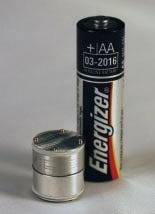May 24, 2010
|
A miniature generator extends battery life in medical devices by harvesting vibrations from such movements as a person walking. |
A miniature generator is picking up good vibrations and converting them into power sources. Developed at the University of Michigan (U-M; Ann Arbor), the energy-harvesting device could efficiently support implantable and body-worn medical devices by converting energy generated by movement into a supplemental power source.
Unconventional sources of power derived from such environmental factors as heat and pressure fluctuations are currently under investigation in laboratories around the world. In U-M's lab, however, researchers are focused on energy scavenging from vibrations or motion found in the environment.
"There are a lot of groups around the world that have done work in this area of vibration energy scavenging," explains Khalil Najafi, chair of electrical and computer engineering at U-M's Engineering Research Center for Wireless Integrated Microsystems. "But a lot of the applications people have looked at so far, or a lot of the designs people have developed, either operate at relatively high frequencies or are from applications where the vibration is quite periodic." Other technologies tend to depend on predictable, periodic sources; however, most kinetic energy produced by environmental stimuli does not occur at regular or periodic intervals, Najafi adds.
The U-M team's parametric frequency-increased generator (PFIG), on the other hand, is designed to produce moderate frequencies of power from sources emitting irregular, low frequencies of motion, such as a person walking. It can scavenge energy from frequencies of 10 Hz and lower by putting a twist on conventional vibration energy-harvesting techniques.
In most vibration-based scavengers, Najafi notes, there is a large mass that is suspended, supported by a beam, and packaged in a housing. Motion of the housing, in turn, causes movement of the mass. It is that motion that yields power. "If the frequency of that motion is low, then the amount of power you get is very small," Najafi states. The PFIG works in a similar manner, but because the size of the mass is much larger than in comparable scavenging methods, the motion of the mass is very low frequency.
"A lot of scavengers take that motion and directly convert it to electrical energy right at that point," Najafi observes. "We have added one more step in there, what we call frequency up-conversion. We take the motion of this larger mass and then convert that mechanical motion to another mechanical motion--another structure that then operates or runs at a much higher frequency."
Converting low-frequency motion into high-frequency motion and, ultimately, into electrical energy, enables the U-M generator to harvest vibrations more efficiently than other scavenging techniques, according to the researchers. In fact, the scientists' research has shown that the PFIG can produce up to 0.5 mW of power from typical vibration amplitudes associated with the human body. With such capabilities, the generator could potentially be used as a supplemental power source in a variety of medical devices, including implants and body-worn monitoring products. It could help to offset battery depletion in pacemakers, for example, thereby extending the life of the implant and delaying the need for risky replacement surgery.
Although the researchers initially see the generator as providing a supplemental power source, it could someday supplant the use of a battery. In order for that to be possible, however, the generator would require the addition of a storage device to power the medical product when the body is at rest, according to Najafi. "The device has to operate all of the time, but the source of external energy might not always be present--this would be mostly motion of the individual or, depending on where this is placed, the motion of the chest or the heart beating," he says. "The amount of energy depends on the size of the generator you put in there. The natural motions of the body, even when sleeping, can still [produce] vibrations or motions from the chest wall."
You May Also Like



